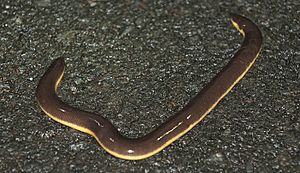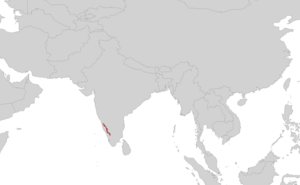Yellow-striped caecilian facts for kids
Quick facts for kids Ichthyophis beddomei |
|
|---|---|
 |
|
| Conservation status | |
| Scientific classification | |
| Kingdom: | |
| Phylum: | |
| Class: | |
| Order: | |
| Family: | |
| Genus: |
Ichthyophis
|
| Species: |
I. beddomei
|
| Binomial name | |
| Ichthyophis beddomei Peters, 1880
|
|
 |
|
| Ichthyophis beddomei range | |
Ichthyophis beddomei is a fascinating type of caecilian. These amazing creatures are sometimes called Beddome's caecilian. They belong to a group of animals known as the family Ichthyophiidae. Caecilians are amphibians, just like frogs and salamanders, but they look more like worms or snakes.
Beddome's caecilians have a unique appearance. Their bodies are a dark violet-brown color. They also have bright yellow stripes that run all the way from their head to their tail. Their upper lip and lower jaw are also yellow. These interesting animals live in the Western Ghats region, which is a mountain range in India.
Contents
What is a Caecilian?
Caecilians are a special kind of amphibian. Unlike frogs and salamanders, most caecilians do not have legs. They have long, slender bodies that help them move through the soil. They are often found underground, where they hunt for food.
Where Do They Live?
Beddome's caecilians are found in the Western Ghats of India. This area is known for its rich biodiversity. The Western Ghats is a mountain range that runs along the western coast of India. It has many different types of forests and habitats.
Habitat of Beddome's Caecilian
These caecilians prefer to live in moist, tropical forests. They spend most of their lives hidden underground. They can be found in damp soil, under rocks, or in leaf litter. This helps them stay safe from predators and find food.
Appearance of Beddome's Caecilian
The Beddome's caecilian has a distinctive look. Its body is smooth and dark, almost like a deep purple-brown. The bright yellow stripes are a key feature. These stripes run along the sides of its body.
Body Features
The yellow stripes extend from the head to the very tip of the tail. The area around their mouth, including the upper lip and lower jaw, is also yellow. This color pattern helps them blend into their environment. Their skin is smooth and moist, typical of amphibians.
What Do They Eat?
Like many caecilians, Beddome's caecilians are carnivores. This means they eat other animals. They are important predators in their underground world.
Diet of a Caecilian
Their diet mainly consists of small invertebrates. They use their strong jaws to catch prey. Common foods include earthworms, insect larvae, and other small creatures found in the soil. They are skilled hunters, even without legs.
Life Cycle of Caecilians
The life cycle of caecilians is similar to other amphibians. They start as eggs and then develop into adults. Some caecilian species lay eggs, while others give birth to live young.
Reproduction
Little is known specifically about the reproduction of Beddome's caecilian. However, many caecilians lay their eggs in moist soil. The mother often stays with the eggs to protect them. Some species even feed their young with a special skin layer.
Conservation Status
The Beddome's caecilian is currently listed as "Least Concern" (LC) by the IUCN. This means their population is stable for now.
Protecting Their Home
Even though they are "Least Concern," it's important to protect their habitat. The Western Ghats faces threats from deforestation and habitat loss. Protecting these forests helps all the animals that live there, including Beddome's caecilians.
Images for kids
See also
 In Spanish: Ichthyophis beddomei para niños
In Spanish: Ichthyophis beddomei para niños




